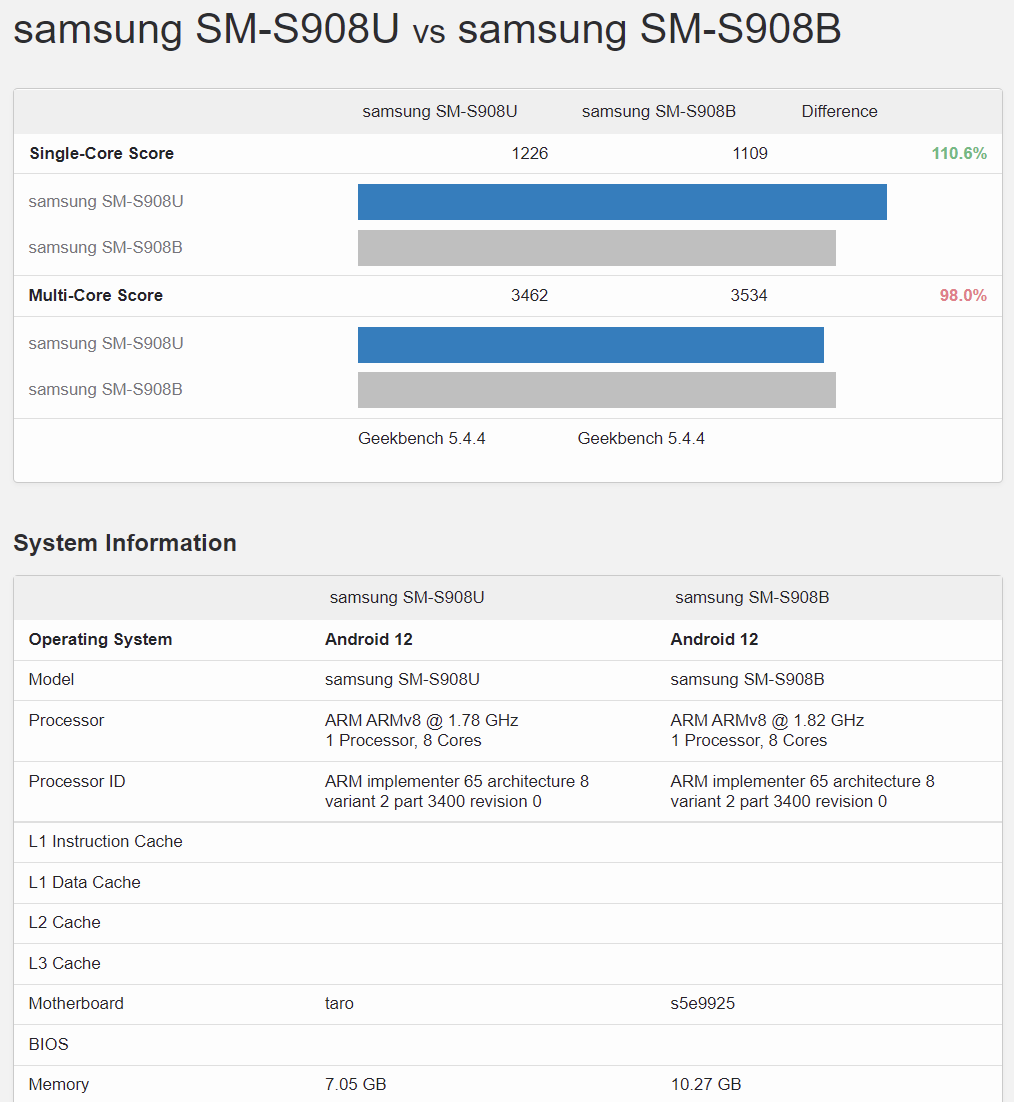Samsung Exynos 2200 vs Snapdragon 8 Gen 1 specs and performance on the Galaxy S22 Ultra
We may earn a commission if you make a purchase from the links on this page.

Samsung has launched the Galaxy S22 and Galaxy Tab S8 series preorder reservations, and you can earn $50 credit for reserving the phones early from the links below, plus some "exclusive offers" that will be revealed when the preorder period starts.
Samsung Galaxy S22 Ultra Snapdragon vs Exynos 2200 benchmark
We delved into the Geekbench 5 database, and dug out the highest score sets of the Exynos Galaxy S22 Ultra model (SM-S908B) and the Snapdragon S22 Ultra version (SM-S908U). As you can see, the difference in their synthetic benchmark scores is not big, but it was interesting to observe the ray tracing performance where the mobile AMD RDNA 2 GPU in Exynos 2200 should've had a leg up.

Galaxy S22 Ultra Snapdragon vs Exynos 2200 Geekbench scores
Samsung Exynos 2200 vs Snapdragon 8 Gen 1 specs and features
The most important new Exynos 2200 features to be found on the Galaxy S22 models:
- First hardware accelerated ray tracing (RT) and variable rate shading (VRS) in a mobile chipset
- Samsung Xclipse GPU based on AMD's RDNA 2
- 4nm Samsung EUV production method
- 10 Gigabit 5G modem with sub-6GHz and mmWave connectivity
- 4K@120Hz refresh rate display resolution support
Here's a list of the most important new Snapdragon 8 Gen 1 features:
- X65 5G modem with 10 Gigabit download speeds.
- First 18-bit image signal processor for mobile.
- First 8K HDR10+ video capture for mobile.
- Mega low-light capture snaps 30 images and merges the best parts into one shot.
- Always-On ISP for fast face unlocking and locking.
- 7th Gen Qualcomm AI Engine for voice analysis and Leica Leitz Look bokeh filters.
- Bluetooth Low Energy audio features like broadcasting, stereo recording, and voice back-channel for gaming.
- First platform with Android Ready Secure Element support, the new standard for digital car keys or drivers’ licenses.
As for how does the new Exynos 2200 stacks up against its direct Snapdragon 8 Gen 1 competitor, last year's Exynos 2100 in the S21 Ultra, and Apple's A15 monster in the iPhone 13, here's a quick comparison of their specs and features.
| Snapdragon 8 Gen 1 | Exynos 2200 | Exynos 2100 | Apple A15 | |
|---|---|---|---|---|
| Production process | Samsung 4nm EUV | Samsung 4nm EUV | Samsung 5nm EUV | TSMC 5nm 2nd gen |
| Processor cores | 1xCortex-X2@3GHz 3xCortex-A710@2.5GHz 4xCortex-A510@1.8GHz | 1x Cortex-X2 3x Cortex-A710 4x Cortex-A510 | Exynos X1@2.91GHz 3x Cortex-A78@2.8GHz 4x Cortex-A55@2.2GHz | 2x Avalanche@3.23GHz 4x Blizzard@1.8GHz |
| GPU | Adreno 730, 30% faster and 20% more frugal | Ray-tracing Samsung Xclipse 920 with AMD RDNA 2 architecture | ARM Mali-G78 | Apple custom quad-core (5-core on the iPhone 13 Pro models) |
| Modem | X65 5G modem (integrated) up to 10 Gbps over 5G Global iSIM multi-SIM card support | Samsung 5G modem (integrated) 5G downloads up to 10Gbps (mmWave), 5.1Gbps (sub-6GHz), or 3Gbps (4G LTE), 8xCA Uploads: up to 3.67 Gbps | Exynos 5123 (Category 24) Downloads up to 7.3Gbps (mmWave), 5.1Gbps (sub-6GHz), or 3Gbps (4G LTE), 8xCA Uploads: up to 422 Mbps | Qualcomm X60 5G modem |
| AI co-processor | 7th Gen Qualcomm AI Engine | FP16 NPU | Tri-core NPU, up to 26 TOPS | 16-core Neural Engine, up to 15.8 TOPS |
| Video encode | 8K HDR10+ | Up to 8K decoding: 60fps with 10-bit HEVC(H.265), 30fps with 10-bit VP9, AV1 Up to 8K encoding: 30fps with 10-bit HEVC(H.265), VP9 | 8K HDR at 60fps 4K HDR at 120fps | 4K HDR+ at 120fps |
| Features support | QHD+ @144Hz or 4K@60Hz display refresh Demura and subpixel rendering for OLED uniformity First 18-bit ISP, mega low light capture merges 30 images in one shot for brighter, sharper pictures Qualcomm FastConnect 6900: Bluetooth 5.2, Wi-fi 6E (up to 3.6GBps) | 4K@120Hz or QHD+ @144Hz display refresh up to 200MP in single camera mode, Single-camera 108MP @30fps, Dual-camera 64MP+ 32MP @30fps Integrated Secure Element (iSE) to store private cryptographic keys AMIGO performance optimization technology | UFS 3.1 storage support for up to 2.9GB/s speeds Single-camera up to 200MP up to 16 GB DDR5 Variable 120Hz display refresh rate | Computational photography Cinematic Mode video bokeh Machine learning capable of 15.8 trillion operations per second |
As you can see, Qualcomm and Samsung aren't playing around, and offer some unique 5G connectivity and other features that Apple will have to catch up with when its next generation A16 processor hits the iPhone 14 in the fall of 2022. That one is reportedly also being done on the 4nm process, but until then the Exynos 2200 and Snapdragon 8 Gen 1 may stay the undisputed connectivity kings for the 5G era.
The AMD-based Xclipse 920 GPU of the Exynos 2200 doesn't shine in benchmarks compared to the Adreno 730 in Snapdragon 8 Gen 1, but the ray tracing and variable rate shading support more than makes up for the synthetic scores. Moreover, it supports 4K resolution displays with up to 120Hz refresh rate, whereas the Snapdragon 8 makes do with 60Hz refresh support at that resolution only.
We'll do our own set of benchmark tests to demonstrate for you how the S22 Ultra performs in real life when we get our hands on an Exynos 2200 and a Snapdragon 8 Gen 1 version like the one that will be sold here in the U.S.













Things that are NOT allowed: